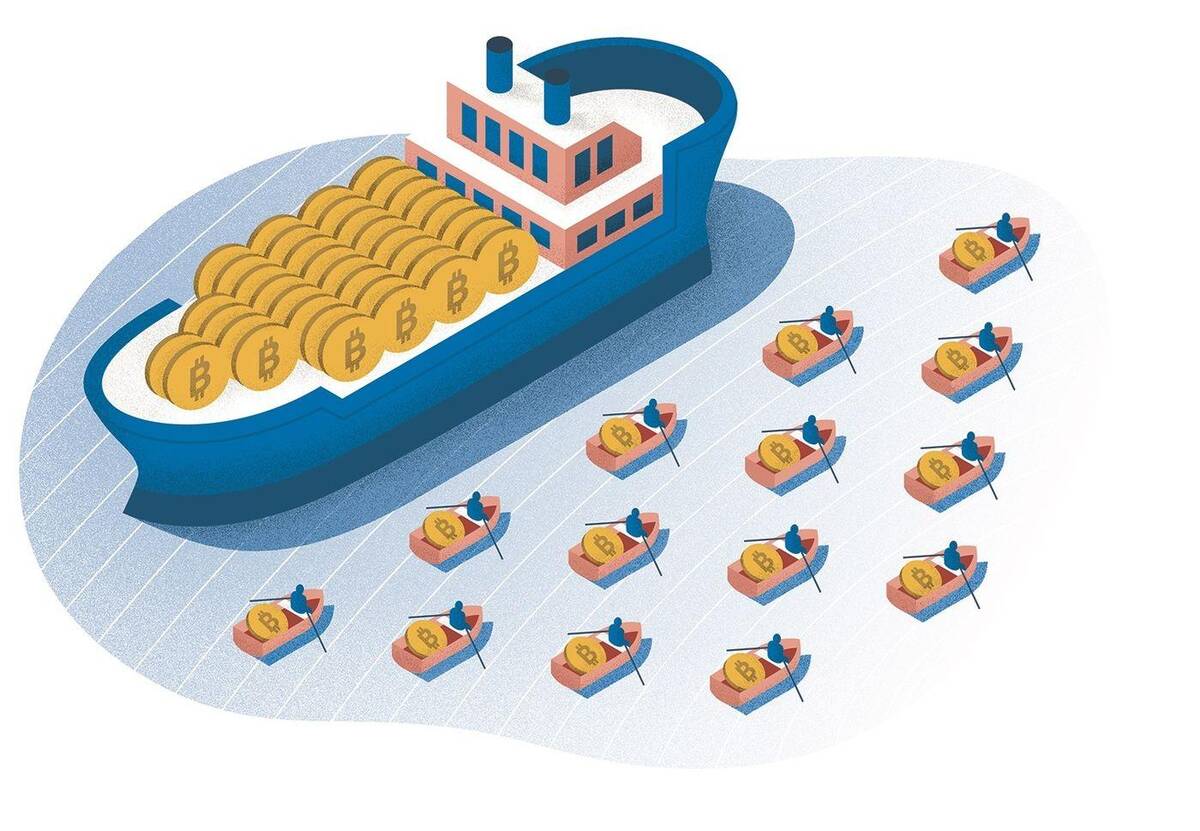Strategy Oct 2, 2018
The Blockchain Revolution Has Reached a Crossroads. What’s Next?
Bitcoin and its ilk need to become more efficient without losing their trademark decentralization.

Riley Mann
With more than a thousand cryptocurrencies now loosed upon the world—for a total market capitalization of roughly $200 billion—it’s clear that the likes of Bitcoin and Ethereum are here to stay. But it is also clear that the “blockchain revolution” has reached a crossroads.
Last year, Bitcoin divided itself after failing to solve an internal dispute over how to scale its network, and Ethereum has faced its own rough weather, from software bugs to governance issues. While both are still making headlines, they are a long way from establishing a viable alternative to global financial networks. The question for these and other cryptocurrencies is: Can they scale?
“This is the big challenge, and it’s one that involves an uncomfortable trade-off,” says Sarit Markovich, a clinical associate professor of strategy at the Kellogg School. “On the one hand, there’s a strong push to increase the blockchain’s efficiency. On the other hand, this needs to be done while preserving its decentralized structure. The problem is, you can’t do both.”
For Markovich, there is little question that scaling would involve some degree of centralization. That means each cryptocurrency will have to strike a balance between growing its network and staying true to the principles of transparency and autonomy inherent to a decentralized ledger.
Without that balance, currencies will either stagnate—due to slow traffic—or fail to attract and retain users, since centralizing control in effect means emulating the banks and financial institutions to which they were meant to be an alternative.
“There isn’t just one solution for this,” she says. “Each community will choose an approach that works best for them. But the key is that these networks can’t just scale up without a plan. They have to find a neutral way to centralize for efficiency, and they’ll need to do so without disrupting established protocols with community consensus.”
A Network Problem with a “Twist”
In the early days of cryptocurrencies, the blockchain—the digital ledger that makes these networks possible—was advanced enough to suit the needs of a small, eclectic group of alternative investors. The goal was to allow financial transactions that did not require middlemen such as banks or credit card companies.
Digital coins were “mined” and shared through a quirky, mysterious process involving mathematical puzzles. The network processed transactions slowly, but the digital ledger was fully transparent and updated in real time. And users liked the fact that they were not beholden to any single powerful institution.
As the network grew, however, the slow-and-steady approach became a problem: the movement of digital coins around the globe was simply too inefficient. For every transaction Bitcoin processed, Visa handled several thousand. A fraction of Bitcoin users felt that in order to go mainstream, they would need to boost efficiency by changing the blockchain’s “protocol,” or the rules that govern the size, speed, and process of verifying transactions. Others believed that doing so would mean compromising the transparent, secure, decentralized network they had signed up for.
This dispute led Bitcoin to divide into two currencies last year: Bitcoin Cash and Bitcoin Core. Bitcoin Cash, the group that argued in favor of efficiency, chose to increase the size of the “blocks,” which allowed them to process transactions more quickly. But this division—known as a “hard fork”—does not solve the long-term problem of how to scale effectively. There is plenty more to argue about, such as how to increase the size of the blocks without compromising security (with larger blocks, it takes more time for information to spread through the network, which some see as a major risk). What happens when there is a disagreement within the Bitcoin Cash community? Will there be another fork? Cryptocurrencies can’t grow if they are constantly undergoing schisms.
“In many ways it’s a classic network problem,” Markovich says. “But there’s a twist.”
When a company like Comcast or AT&T needs to solve a network problem (such as how to transfer massive amounts of data without causing congestion), they don’t need consensus from their millions of customers. The executive team simply makes a decision, and software engineers execute it. And while there are certainly those who pay close attention to how these networks are managed—for example, net neutrality advocates—most are willing to accept a measure of centralized control if it means their YouTube videos load.
But the blockchain community is different.
“Bitcoin fanatics will have to accept some degree of centralization. At the same time, any company hoping to benefit from these networks has to recognize that the solution can’t be total centralization.”
“When it comes to blockchain, this mentality becomes more problematic,” Markovich says. “The whole purpose was to move away from centralized authority.”
So what wins, efficiency or autonomy? As Markovich sees it, the only way forward is to find an acceptable compromise. The future of blockchain—at least in terms of undergirding digital currency—seems destined to land somewhere between the two extremes.
“Bitcoin fanatics will have to accept some degree of centralization,” she says. “At the same time, any company hoping to benefit from these networks has to recognize that the solution can’t be total centralization. Both sides have to compromise.”
Keeping It Neutral
That compromise could take many forms, as a quick scan of cryptocurrency websites will attest. Every blogger, investor, and “miner” seems to have an opinion on how to solve this network problem that is preventing platforms like Bitcoin and Ethereum from achieving stable growth.
One solution involves bundling certain transactions “off chain” and registering them on the digital ledger after a given period of time. (This would be the equivalent of seeing one’s monthly Starbucks bill instead of a breakdown of each purchase). One problem with this solution is that it requires customers to open pre-paid credit lines with multiple vendors. Furthermore, it does not allow the entire network to verify every transaction, which potentially opens the door to fraud and other security issues, since there would be less information on the log.
The other solution is coming up with a centralized algorithm that would optimize the flow of transactions among the network’s various nodes. This would increase processing speeds while still maintaining full transparency. The challenge is finding a way to keep the algorithm neutral.
“This is where a lot of people are focusing their efforts,” Markovich says. “It’s tough, because if you start to prioritize one transaction over another in the interest of efficiency—for example, deprioritizing nodes in developing countries—that’s going to be a problem. Any perception of bias would make the community feel they’re losing too much. It’s a compromise they won’t accept.”
The best solution would also be one that doesn’t require changes to the blockchain’s protocol, because that would mean having to seek buy-in from all stakeholders, thus increasing the chances of disagreement and, potentially, a fork.
“Changes to protocol make people nervous about security,” Markovich says. “So ideally you want an algorithm that doesn’t threaten security or create priority or bias in the network. Because otherwise you’ll need to find a way to get everyone on board.”
Finding the Right Balance for Governance Issues
Beyond the technical problem of increasing network efficiency, there is the social problem of addressing the needs of a digital community. The Bitcoin community spent two years debating whether and how to scale before agreeing to disagree, and such prolonged deliberations are not atypical.
“You can’t get much done without a central authority,” Markovich says, “and that raises serious governance issues. This is especially hard given how easily people can express their ideas on Twitter polls and other forums. And it gets even more complex when those who govern these forums have their own opinion.”
Consider what happened after the 2016 hack of the DAO, a program that was designed to democratize project funding on the Ethereum network. The hack resulted in more than $50 million of stolen cryptocurrency. Ethereum’s founder executed a “hard fork” to isolate the hacker from the original blockchain network in an effort to essentially freeze his assets.
“That was a governance decision, and it was a huge deal at the time, because a number of people were saying, ‘Well, [the hacker] didn’t do anything wrong—he just exploited the protocol,’” Markovich says. “But at the end of the day you needed some authority to undo a transaction that should have been immutable and decide how the network would move forward.”
The episode revealed what subsequent volatility has reinforced: without some form of centralization, cryptocurrencies are vulnerable to community strife and inefficiencies. If they are going to be secure and efficient, they might have to sacrifice some of the hacker-libertarian ethos that went into designing these systems and potentially some of the democratic aspects of the community.
“It’s all about finding that middle ground where people can be comfortable,” Markovich says. “Almost everyone sees the problem, but will they accept a given solution? That will be interesting to watch.”



